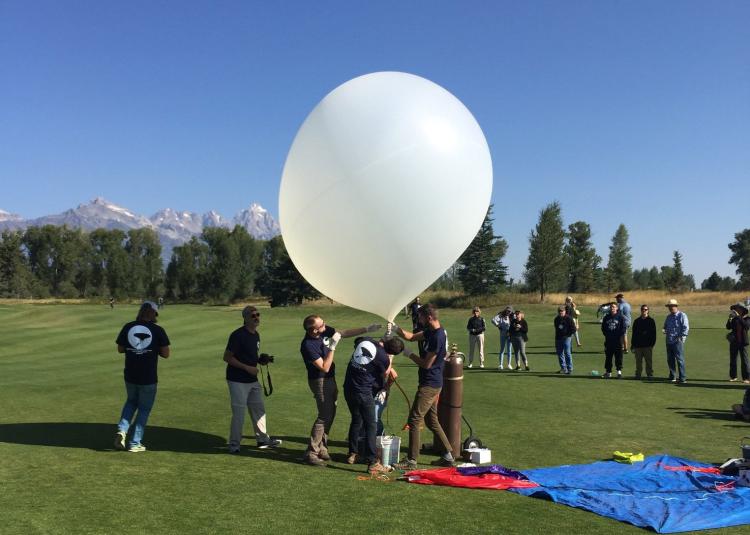
By Kenna Bruner
As graduate student Viliam Klein watched the total solar eclipse from the ground in Jackson, Wyoming, he also kept an eye on his computer screen as it tracked the ascent of his high-altitude balloon. The helium-filled balloon carried a 360-degree camera to 105,000 feet above the Earth to film the moon’s shadow during the Aug. 21 eclipse.
Launching the camera was just the start of his odyssey. Klein then had to retrieve the camera after it landed 50 miles from the launch site in the trackless Wyoming wilderness. Klein and a team of five friends set off on a three-day mission to find the camera, which conveniently landed in a bush above tree line, not in a treetop or at the bottom of a lake or a steep ravine as feared.
The first day of the search, Klein and his crew hiked 14 miles over rugged terrain, across a wide stream and up a steep butte where, to Klein’s relief, the camera and its 550 gigabytes of video were intact.
“This was the epitome of engineering,” Klein said. “It’s solving the ‘devil in the details’ problems, and there were a lot of details in this project.”
An aerospace engineering doctoral student at CU Boulder, Klein works on GPS systems for the International Space Station. As an undergraduate and now as a graduate student, Klein has worked on a scientific balloon project with NASA.
The first total solar eclipse to cross the United States in nearly a century was the perfect event for his own high-altitude balloon experiment.
“This was truly a once-in-a-lifetime opportunity,” Klein said. “What I hoped to capture was exactly what I got—video of the entire circular shadow of the moon on the ground with plenty of horizon around it.”
The inspiration for the project came about when he saw a video of a 2016 total solar eclipse taken by a passenger from an airplane window. Alaska Airlines had adjusted its flight path to allow viewing of the eclipse seen over the Pacific Ocean.
“What I think is particularly beautiful about the Alaska Airlines video is that you can see the shadow of the moon coming toward you,” he said. “When I saw that I got to thinking that the video was really nice, but I wanted to find a way to improve on it. To do that would mean going higher than the airplane.”
Airplanes fly at an altitude of about 35,000 feet, but high-altitude balloons can go up to 100,000 feet, providing a much better view of the Earth.
The balloon carried six GoPro OMNI cameras pointing in different directions. The camera payload weighed just over 6 ½ pounds. The camera was purchased by the Ann and H.J. Smead Aerospace Engineering Sciences department and the Fiske Planetarium supplied the rest of the funding for the project.
Klein was able to conduct a test flight this summer when he helped Front Range-area high school students launch a high-altitude balloon during one of the university’s Science Discovery camps, which Klein attended as a kid. The test flight helped him prepare for his high-altitude balloon experiment.
Once it reached altitude, the balloon popped and the camera fell to Earth. A parachute deployed at 20,000 feet, and the camera descended at 20 mph. Because the balloon and parachute couldn’t be steered, a tracking device allowed Klein to follow its path on a topographic map as it landed in the Gros Ventre Wilderness east of Jackson.
The logistics of pulling off such a feat, from conception to completion, required focusing on thousands of details in order to be prepared for anything. From taking a soldering gun in case Klein needed to repair a wire (he did), to carrying bear repellant in case he and his friends encountered a bear (they didn’t).
The video will be shown to the young Science Discovery students and to the public at the Fiske Planetarium on campus. As for Klein, when he finishes his doctorate, he wants to build instruments for spacecraft or high-altitude balloons.
“I’m really grateful the university trusted me enough to provide the resources for me to pull this off,” he said. “I really hope I got something worthwhile for CU to use.”
CU students and friends who helped Klein with the launch or recovery:
- Jordan Holquist: Aerospace grad student
- Tyler Mixa: Aerospace grad student
- Jack Greene: Civil engineering grad student
- Rick Soltas
- Paul Nicholas
- Joel Boymel
